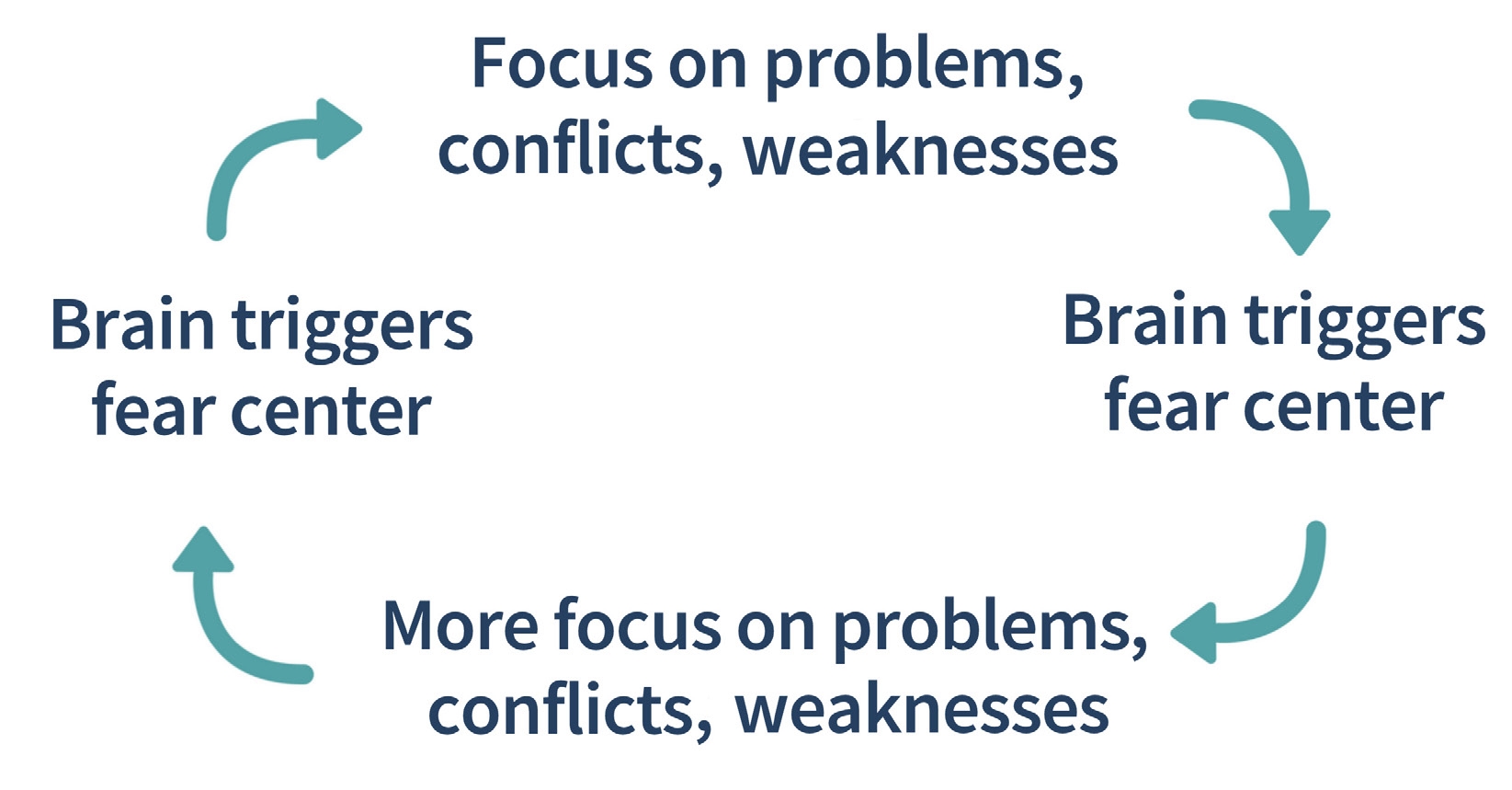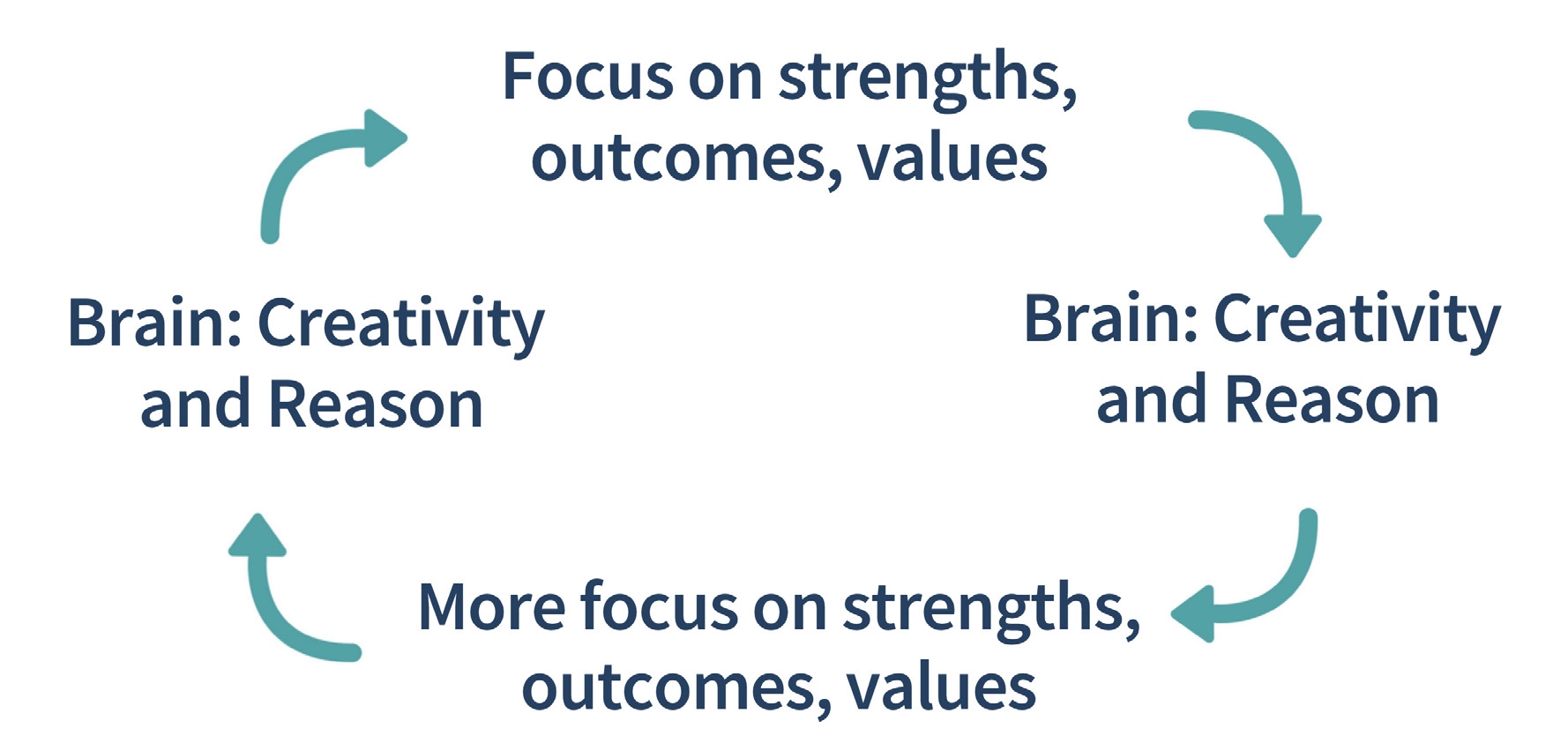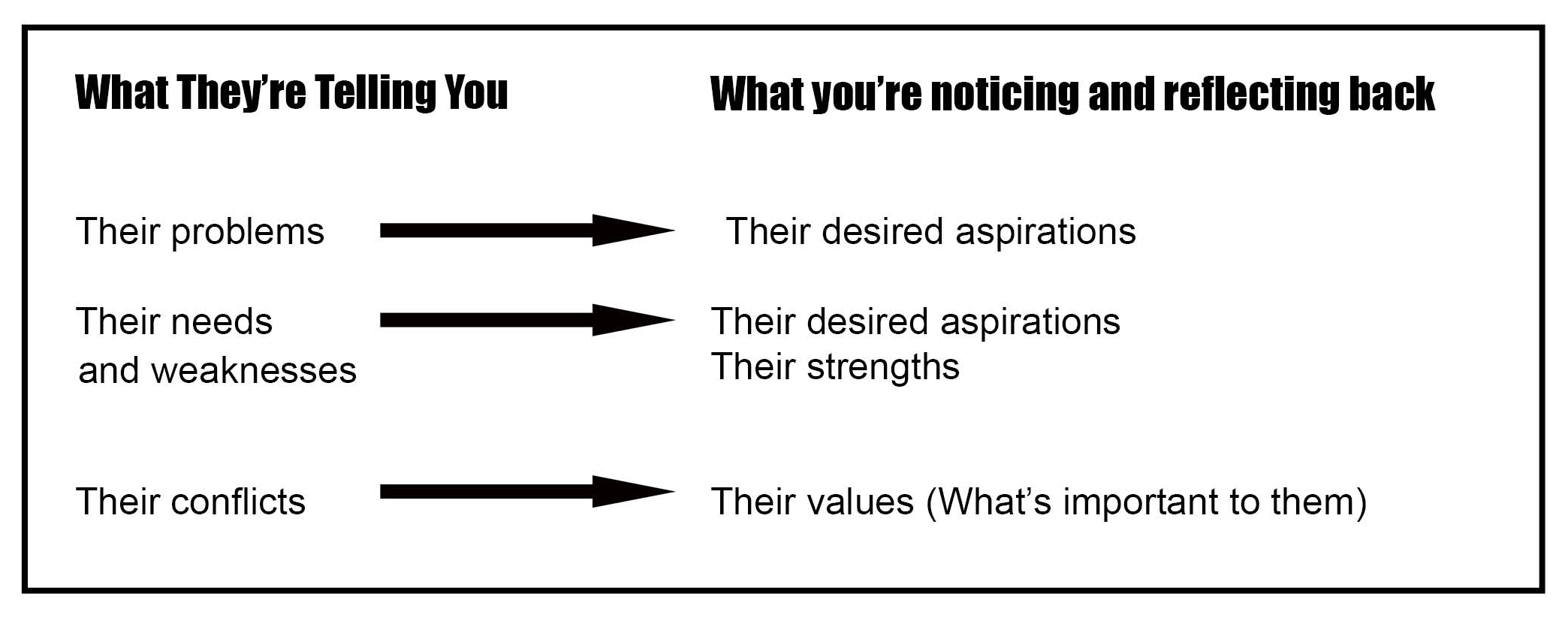Catalytic Listening is a practice for bringing out the best in the people around us, simply by the way we listen when they are speaking.
Because of that, Catalytic Listening is embedded into every aspect of the Catalytic Thinking framework. In every interaction, we choose whether to listen or speak. When we choose to listen, we have further choices – choices about HOW we listen.
When we are listening through the lens of Catalytic Listening, we are opening the door to possibility and potential, catalyzing that potential in the people we are listening to and ourselves.
This is not about making something happen or getting someone to do something. It is not about making people feel better.
Catalytic Listening is about people feeling heard and seen for their own innate wisdom and potential.
It is about seeking the potential in any situation by inviting others to be their best selves, simply by what we listen for when they are speaking. And it is about people finding their own answers, based on wisdom they may not even realize they have.
What you will find as you practice Catalytic Listening is that people will immediately respond when you invite them to access their own wisdom, aspirations, and values.
And that is what makes Catalytic Listening catalytic!
Catalytic Listening: The Science
The most favorable conditions begin and end with bringing out the best in people vs. focusing on stuff (money, food, education).
~ 2nd Core Tenet of the Catalytic Thinking framework
Because the cause-and-effect of our actions begins with our thoughts, the 2nd tenet of Catalytic Thinking focuses on aligning our actions with the mechanics of how our brains work.
In our daily interactions, people often talk about what’s wrong in their lives – their problems and worries. In both the person who is speaking and the person who is listening, these negative conversations trigger the brain’s reactive survival center. If you’ve ever felt like these sorts of conversations are bringing out the worst in you, you are not imagining that. Those negative conversations trigger the release of the fight-or-flight chemicals in your brain. (If you are curious about the brain science of that fear trigger, this short video provides a great introduction.)

As we learn to ask and listen in ways that bypass the brain’s fear triggers, we are creating a path of least resistance for accessing our creativity and rational thought.
Those favorable conditions include
• The person you are listening to feels honored for their wisdom and experience
• They are reminded of (and therefore have access to) their own strengths
• That person is able to clearly articulate their values – the things that are most important to them
• They are able to see their aspirations in a positive framing vs. a “less negative” framing
• They are able to find answers to their own questions and problems, rooted in their own wisdom and experience
Those favorable conditions create a feedback loop as well, this one with more favorable results.

When we are practicing a more mindful way of listening to each other, we are working with the cause-and-effect of our own brains, to bring out the best in the people around us and ourselves.
The practice of Catalytic Listening is therefore about learning to listen and reflect what we are noticing, when we are focused on the other person’s potential. To do so, we must first ensure the reflexive part of our brains are feeling safe. From there, the magic happens as Catalytic Listening helps access the rational, creative, compassionate parts of both the other person’s brain, and your own.
First Quiet the Reflexive, Reactive Brain
The first step in Catalytic Listening is to prepare the soil, so that a catalytic conversation can grow. This is about calming your reactive brain while doing the same for the person you are listening to. This will help that other person feel safe and trusting, while simultaneously keeping you from worrying that you have to have the answer or solve that person’s problems. This first step can take any number of approaches, all of which are commonly taught to counselors, social workers, and therapists, to create the safe space for people to find their own answers.
Some people take a moment of meditation, breathing and getting present as they listen to the other person begin talking.
Some practice holding space, walking alongside that person without judgment or the need to fix things. (This article by Heather Plett is particularly helpful for the practice of holding space.)
As we feel the urge to speak, we can simply utter words like uh-huh, or wow. Or just nod. We can invite that person to tell us more, using just those words… “Can you tell me more about that? I want to understand as much of the picture as possible.”
This is the opposite of what so many of us commonly do, all in the name of trying to help. How often do we ask questions that are actually advice in the form of a question…
• Have you tried X? What about Y?
• Have you thought of X?
• What would it make possible if you did X?
These kinds questions, generally asked with the pure intention of helping solve the other person’s problems, frequently produce the opposite result, making that other person feel challenged and triggering their reflexive, reactive brain. And here’s why: These questions are actually about our ideas vs. the other person’s own wisdom. As author and artist Austin Kleon says, “All advice is autobiographical.”
For a more detailed look at the back-firing dance of advice,
this post provides great detail.
Therefore, in order to create a safe environment and prepare for the catalytic part of the conversation, we just listen with an open heart, seeking to understand what they are experiencing, and helping them to keep the reflexive, defensive parts of the brain feeling safe and trusting.
Now, the Catalytic Part of Catalytic Listening
Once the reactive part of the brain is feeling safe, the catalytic part of Catalytic Listening relies on what we do from there.
At its core, Catalytic Listening is a practice of noticing.
Because what we pay attention to is where we will focus our energy.
When we pay attention to stories of drama, conflict, blame, and lack, that is where a conversation will go. On the other hand, when we mindfully notice those aspects of a conversation that will bring out the best in the other person, that is where the energy in the conversation will go.
Catalytic Listening is therefore about noticing the things our companions are telling us, that help uncover their potential for finding their own wisdom in the situation.
We are so used to going down the rabbit hole as people tell us their problems. We follow them right down how bad it is, how hopeless they feel. Feeling their despair or sadness leads us to want to fix it for them, triggering all the brain loops noted above.
Catalytic Listening is about just the opposite of that. It is about listening for what people are telling us from the point of view of their potential – things they are telling us that they don’t even realize they are sharing.
When people talk about what’s wrong, they are telling one story from one point of view. And that point of view has zero power, with zero potential for anything except getting more negative, as you all step into the darkness together. The more we tell ourselves those negative stories, the more we are actually taking away our own power.
But when we are able to see glimpses of that power, we can open the door to our potential. That is what will bring out the best in everyone in the conversation.
By listening for what is strong and powerful, you are then able to reflect those powerful attributes back to that other person. That change of focus can open the door to the creative ideas of both your brain and the person you are listening to, seeing through the lens of potential versus reactivity. And that leads to answers none of us may ever have thought of with our otherwise reactive brains.
Catalytic Listening: Three Strengths to Listen for

When people are sharing their problems, they are also sharing the outcomes they want once that problem is no longer a problem – their aspirations.
When they are sharing their weaknesses and needs, they are also sharing their strengths.
And when they are sharing their conflicts, they are sharing the values at the core of those conflicts – the things that are most important to them.
As you begin listening for these attributes, you will notice something powerful:
More often than we realize, we do not need to ask people about their strengths, their values, or their aspirations.
People are already telling us so much about their potential. We are just not accustomed to listening for it.
Catalytic Listening trains us to NOTICE that potential, without having to ask, “So, what do you see as your strengths?”
Focusing on Aspirations
When people talk about their problems, what they really want is not just that the problem be gone, but the positive outcome on the other side of their problems. With Catalytic Listening, we are listening for what GOOD looks like to that person, and then reflecting that back to them, to see if we’re on the right track.
Problem:
I can’t afford tickets to a concert my girlfriend really wants to go to.
Aspiration:
He wants to make his girlfriend happy.
What we can reflect back to them:
Wow, you really want Maria to be happy!
Focusing on Strengths
People may talk about what is not working and what they don’t have – problems and weaknesses. When we focus our attention on those negative aspects, we fail to notice that they are also telling us what IS working and what they DO have to build upon.
Listening for strengths is therefore about listening for what IS working, even as people are sharing what is NOT working. It is about listening for what is STRONG when people seem to only be talking about what is WRONG.
Weakness:
“My team is so disengaged. Out of 10 people, only 2 are worth anything.”
Strength:
2 people are engaged!
What we can reflect back to them:
“What’s going on with the two that are engaged? What keeps them engaged?”
Focusing on Values
People talk about conflicts large and small, all the time. A coworker that is making them crazy. A micromanaging boss. A friend who repeatedly reneges on promises. A gossipy neighbor. Minor annoyances and knock-down fights.
In these conversations, it is easy to go down the rabbit hole with them, laying blame and taking sides.
Catalytic Listening helps us stay out of that hole, as we realize that blame and conflict are always about values – about what is important to each of the parties.
When we reframe that blame and conflict into “values,” we begin to see beyond the story the other person is telling us, to the reason that story is important to them.
Conflict:
Two siblings fighting over a parent’s estate.
Blame:
Mom always loved you more.
I was there for her in the end and you weren’t around
Values:
Feeling loved, by the parent, by the sibling, by the world
What we can reflect back to them:
It sounds like it’s really important to you that people show their love and appreciation. Am I close?
Listening through the lens of values, we can provide that person a deep breath, a step back from the ledge. The drama takes a back seat when we reflect compassion for what they are feeling, as we bring their own values into the light – what is important to them at the core.
The antidote to anger / conflict / blame is therefore LISTENING, and asking about what is important / what matters to that person. This is especially powerful when we learn to listen to ourselves through this lens, noticing and listening to what is important about what is going on in our own heads and hearts.
Practice Exercises:
Remembering how our brains work, we know that humans and other animals are hard-wired to see the world first through the reactive, survival brain. We have built thousands of years of cultural habits and systems that reinforce that hard-wiring.
The following practice exercises are therefore intended to retrain your brain – to recognize when you are operating from that reactive, defensive part of the brain, and to guide you to notice and think things through from the more rational, creative, compassionate parts of your brain.
The more you practice Catalytic Listening, the more you will be strengthening those mental muscles. Which is to say that you will get the most out of these exercises if you use them.
The good news is that you can always take a moment to practice listening, wherever you are, with whomever, at whatever time. As you do so, you will be strengthening your Catalytic Listening muscles and creating a more joyful way of being, all at the same time!
• As you listen to the characters in a movie or TV show…
• As you listen to yourself …
• As you listen to your kid or partner tell about their day…
• As you listen to a coworker…
What are the values at the heart of the conflict that person is telling about? What is important to that person?
What does that person aspire to? What outcomes do they want? Once the problem is no longer a problem, what would good look like for that person?
What strengths does that person have? What do you hear that is a sign of something that is working well – something strong?
The more you practice listening as an act of noticing the strengths, aspirations, and values in others, you will find that people immediately respond when you invite their whole being into the conversation. We humans are not just a sack of problems; our potential is the most powerful parts of who we are as a species.
Noticing that potential, and inviting it into the conversation – that is what makes Catalytic Listening catalytic.
So go right now, try it. And let us know what happens when you do!
For a deeper dive into Catalytic Listening, click here.
…
Photo credit: Ketut Subiyanto from Pexels

